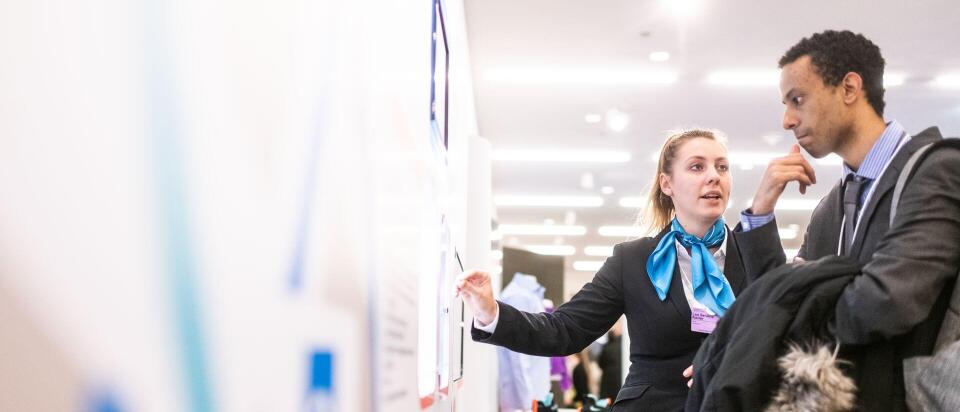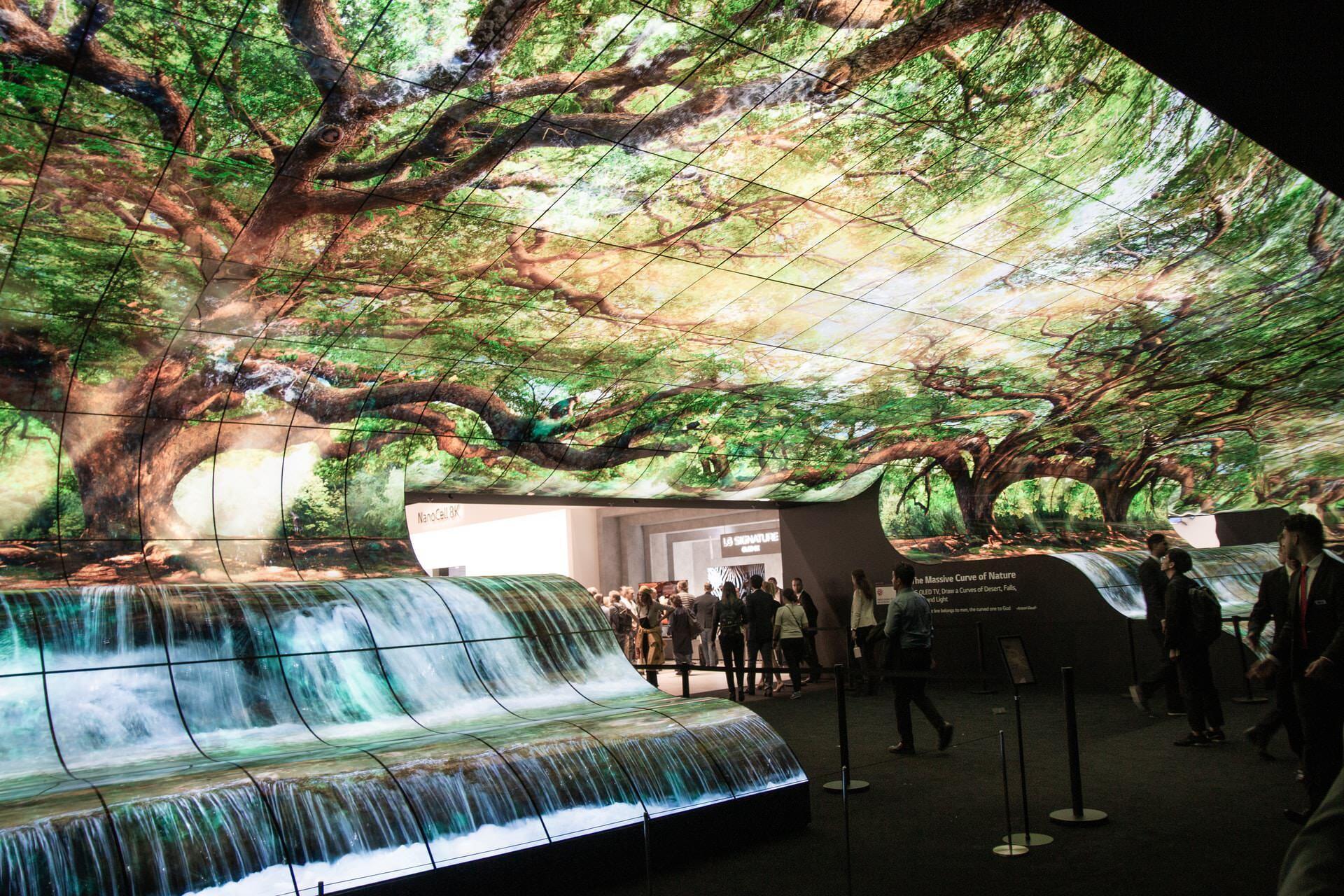
If the visitor can't go to the trade fair, the trade fair has to go to the visitor. In this article you will learn how this looks in detail, what virtual trade fairs look like, how they are organized and what there is to consider.
What is a virtual trade fair?
Trade fairs are fixed dates in many persons working schedules. They are used for exchange, inspiration, discovering trends, acquiring customers and networking with the industry.
For many, they are indispensable in terms of awareness within the industry and customer acquisition - but what if no trade fairs are possible?
Virtual trade shows are the solution. They function as digital replicas of physical trade fairs you're familiar with - only online and not location-based. Visitors navigate around a digital trade fair environment, can move online through exhibition halls and experience a foyer, rooms for workshops, stages with speakers and exhibition stands. It's just like traditional trade fairs - only from the comfort of your desk at home.
As with their role models, virtual trade fairs are also limited in time and follow their own agenda. Sometimes the offers are recorded and are then still accessible on-demand afterwards.
In addition to the obvious purpose of digitizing a trade fair, virtual trade fairs can also be used for internal events by large companies such as annual kick-offs or, for example, for virtual partner events.
Virtual vs. conventional trade fair - What's the difference?
Virtual and digital trade shows differ in two main ways. Here you can find out what that means.
The place
While a conventional trade fair takes place at a specific real location, the virtual trade fair has only a virtual space. For the individual, of course, this makes a noticeable difference in everyday working life. At present, however, this is not always possible.
This may be distressing for some, but a virtual trade fair also has many advantages: For exhibitors, there are sometimes immense costs for an elaborate exhibition stand, which can often only be partially recycled. Travel and hotel costs are also eliminated for both organizers and visitors. It also saves time - but the overall experience is definitely somewhat different.
The communication
Even the biggest fans of digitization will confirm it: There's nothing like personal contact with people. This is also a point that many people appreciate about trade fairs. Personal exchange, feedback and discussions with customers and potential customers, networking with colleagues.
Virtual trade fairs have to make use of various tools here to ensure interactivity: This is achieved with the help of chats, webinars and interactive streams, social media integrations.
Advantages of a virtual trade fair
During the lockdown, there was often no choice but to move the already planned trade fair into the virtual space. But this definitely has many advantages that are also worth considering when hybrid models of conventional and virtual trade fairs are planned for the future.
Save costs
If you move your trade fair to a virtual format, some costs are eliminated: rental of the location, costs for caterers, service and security personnel. Exhibitors save costs for the exhibition stand, for hotel and accommodation and the latter is also eliminated for visitors.
Sustainability
A virtual trade fair is a sustainable format and is therefore ideal for green events and anyone who wants to organize events sustainably. Think of all the trade show setups and booths: Many of the materials and furniture cannot be reused and will be disposed of after the trade fair. Also, the catering and all the disposable cutlery, glasses and serving bowls quickly pile up. There is also no need for all the partly unused give-aways and quantities of flyers and information material.
Data collection and analysis
Whereas at a conventional trade fair you have to rely on the most attention-grabbing design elements possible, and may only be able to capture who has left their data with you, virtual trade fair offer completely different forms of data. Visit times, dwell time, quantity and type of interactivity and leads can even be evaluated in real time. Many tools even offer connections to common CRM tools - so you can immediately capture and process a trade fair lead in your system.
Hygiene and safety
During a worldwide pandemic and beyond, hygiene is an important factor in favour of virtual trade fairs. Virtual concepts have almost no potential for contagion and in 2020 this was often the only way to hold a trade fair at all. You can also save the personnel costs for on-site safety specialists.
What is a virtual booth?
A virtual trade fair stand is closely related to the term "virtual reality". With a virtual trade fair stand, you create a digital twin of a trade fair stand that also exists or could exist in physical reality.
In order to bring the simulation to life digitally, a wide variety of software solutions are possible.
The actual goal of a virtual trade fair stand: Trade fair visitors - or rather users should be able to visit it like a real trade fair booth. One of the most important points to consider is interactivity. A virtual trade fair booth limits the communication channels. It is the responsibility of an organizer to make it experienceable. Communication is the key here! As with a real trade fair stand, you should offer information material in the form of brochures. This already is one of your advantages with a virtual booth: While you can otherwise only offer the brochures that they have previously printed out and taken with them, with a virtual booth you have the linking possibilities of the entire Internet at your disposal - you can respond much better to certain specific requests.
Related to this topic: be sure to emphasize interactivity! Create opportunities for interaction using video chats for 1:1 and group conversations, text chats, opportunities to like, share and post on social media.
Of course, innovative digital options such as virtual reality and 3D rendering are exciting in this context. In a study by Digital Affin, it became clear that 33% of attendees would like to see a virtual trade show booth with 3D and VR, while 67% could do without it. This can suggest several conclusions: Visitors are not yet used to these relatively new technologies, or perhaps even overwhelmed, or simply see them as unnecessary. Depending on the target group and industry, these results can also be interpreted differently. For example, VR and 3D are arguably more common at tech and innovation trade shows than at agricultural trade shows.
Maximilian Mayr, Managing Director of the digitalization pioneer and technology company vystem, offers some important tips on the subject of virtual trade fair stands: "Take away your participants' scepticism about the perhaps new digital format right at the beginning, for example with a short welcome and explanatory video. With a virtual trade fair stand, you have virtually immeasurable possibilities in terms of design and information. Don't flood your attendees, but share well-chosen individual pieces such as videos, photos, PDFs and link collections mainly to your own company website." With this checklist we have compiled the following tips on how you can avoid these mistakes at your virtual trade show.

Virtual trade shows bring the familiar feeling of a conventional trade show directly to your visitors' homes. The picture shows the IFA in Berlin.
Planning a virtual trade fair
At first glance, planning a virtual trade fair seems like a huge project, especially if it wasn't originally planned as a virtual trade fair at all.
Incidentally, the biggest mistake in organizing virtual trade fairs is quite easy to fix, according to Meyer: "Often, a structured schedule is missing. This is because the process of planning, promoting and implementing digital events is unfortunately often underestimated, and the quality of a virtual trade fair suffers as a result. Detailed organization is almost more relevant for virtual trade fairs than for offline events. "Bloopers" can be overplayed live. If, for example, a speaker at a virtual trade fair is not available at the necessary time, it is difficult to fill this gap."
Step 1: Create trade fair concept
First of all, it should be clear which concept and which goals you want to pursue with your virtual trade fair. Who do you want to address, who do you want to reach with which statement? What distinguishes it from other concepts with which you are in competition - what is your USP ? When should your trade fair take place?
Create digital trade fair plan
Just as at a conventional trade fair, framework conditions for the individual exhibitors' stands must also be defined for a virtual trade fair. A space plan is needed! How are individual stands arranged and how large are they? This way you can set guidelines for your exhibitors and their planning.
Determine speaker and organize the program
Speakers and programs are important drivers for your marketing. The more interesting exhibitors and participants find your program, the more likely they are to accept. Look for speakers and work out program points in detail. Do not hesitate to contact your favorite speakers several times.
Invitation management of innovative exhibitors
Speakers and exhibitors often go hand in hand. Rely on quality exhibitors who have valuable contributions to make on your topic and address them personally. Mailing lists, press releases and classic online marketing are all suitable for attracting widespread attention.
Create marketing material
It's a misconception that good products and ideas don't need marketing. Make sure that you arouse the interest of your target group and then keep it. Use as many different channels as possible: social media, newsletters, websites, online marketing, print, PR, trade magazines - everything that helps you reach your target group.
Invitation management visitors
No trade fair without visitors. You surely want to attract as many people as possible to your trade fair - after all, with a virtual trade fair, even more people can be present virtually right away. Managing so many people and addresses and different newsletters and groups works best with a tool like Sweap. This way you send the right information to the right target group and get a good overview of reporting and relevant key figures.
Important: interactivity / technology
This is not a separate step in itself, but it is still extremely important: Make absolutely sure that the technology is working properly. Interactivity is one of the most important success factors of virtual trade fairs. For this, the technology must be right. Bloopers may be able to be overplayed at live trade fairs. But if the technology doesn't play along at a virtual trade fair, the entire trade fair is in jeopardy.
Dry run
No show without a dress rehearsal. This is true for theater, concerts and all stages in the world - and also for virtual trade fairs. Try everything out, have team members who didn't work directly on the implementation or even non-specialist friends and acquaintances put your trade show environment through its paces. Also invite all exhibitors to do the same.
Showtime
It's showtime: Now the excitement is rising! As with a conventional trade fair, you should place the implementation of this event in the hands of experienced event or project managers, so that nothing can go wrong.
Follow-up
The trade fair is over? But it's not quite over yet. The key to success can lie in the right follow-up. Successful follow-up can be more elaborate than it seems at first glance.
Go through data and create KPIs - A virtual trade show has the advantage that you can collect tons of data in real time. This gives everyone involved much better insights: About click numbers, reach, visits and visit duration, which booths and material were viewed the most and so on. Summarize the most important metrics - for your exhibitors, the press, guests and future events.
Budget control - The day of truth! Do all invoices fit? Check the budget once again.
Feedback and thank you: Send a thank you to all participants and also the guests and ask for praise and criticism. Make a note of suggestions for future planning.
Press: Success stories and the KPIs you collected and analyzed in the first step can be shared in a renewed press release. Maybe you realized the first virtual trade show in the industry - or were able to come up with another innovation? You should point this out in any case.
Measuring success: Have you achieved your goals? Record all the details about this as well.
Virtual trade fair software
A good software solution is essential for the implementation of a successful virtual trade show. Technical failure, as already mentioned, can hardly be overplayed at a virtual event. Sweap offers you a reliable software for attendee management, more precisely for guest registration and guest management, furthermore Sweap offers an interface to other platforms.
For virtual fairs we work with our partner vystem, a software for digital fairs from Isardigital. This software offers live stages and presentations, 1:1 and group conversations, custom design implementations, gated content, active visitor engagement and, of course, an analytics section. A case study of Sweap and vystem working together can be found here among others, together both systems were used for the implementation of the first ever digital education fair in Berlin.
Examples of virtual trade fairs
Virtual trade fairs can take place in a wide variety of industries - admittedly, some have it easier than others. For example, the BIldungsmesse mentioned above, as well as other fairs related to education and training, job and career fairs, or fairs with mainly digital topics such as online marketing (e.g. DMXCO), digitization, or gaming, are more likely to be implemented in a virtual environment. Especially since the audience there is very online-savvy and is sure to quickly find its way around a new digital interface.
The situation is probably different for traditional topics, a target group that is not online-savvy, or topics that require multiple senses - such as a trade show for perfumery or gastronomy. But here, too, new virtual trade fair concepts can be found, even if hybrid concepts are more likely to be found here after the pandemic, so that the senses of smell and taste are not neglected. Current examples are the leading trade fair for the hotel and catering industry, intergastra, which took place virtually for the first time, and Agriculture2food from the agricultural sector.
Conclusion
Admittedly, the switch to virtual trade fair offerings was not voluntary for most organizers - there was simply no other option due to the pandemic situation. But the upheaval could also be a good thing: Virtual trade fairs have many advantages - increased reach, better data, sustainability, cost efficiency and, last but not least, hygiene. However, the "human touch" is missing. "The future will be hybrid," Maximilian Mayr also believes. The combination of an offline trade fair, accompanied and supplemented by a digital parallel event, is something we will encounter more often in the future."
